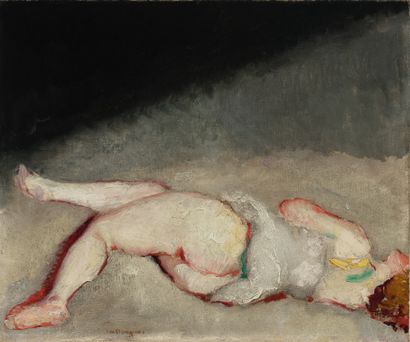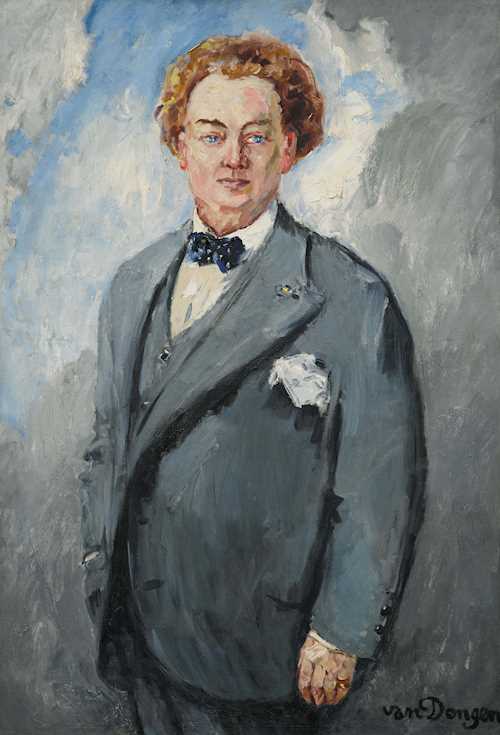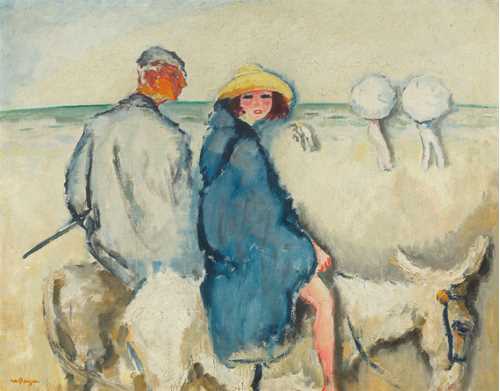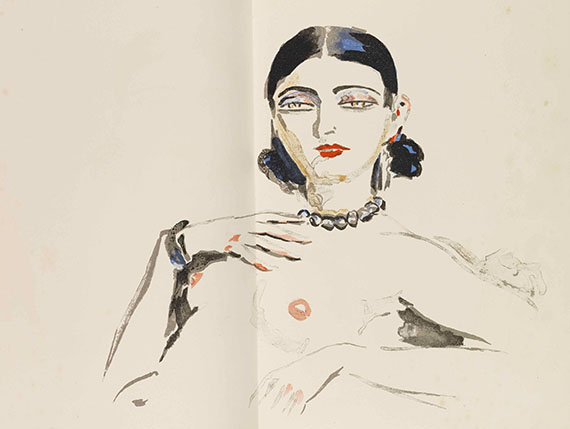Kees van Dongen (Dutch, 1877-1968)Deauville, le champ de courses
Signed 'Van Dongen' (lower right)
Oil on canvas
50.4 x 65.4cm (19 13/16 x 25 3/4in).
Painted circa 1935FootnotesThis work will be included in the forthcoming Van Dongen Digital Catalogue Raisonné, currently being prepared under the sponsorship of the Wildenstein Plattner Institute, Inc.
Provenance
Galerie Paul Pétridès, Paris, no. 15 (acquired by 1954);
Private collection, Paris;
Anon. sale, Loudmer, Paris, 13 June 1994, lot 81;
Anon. sale, Christie's, London, 28 November 1994, lot 27;
Borzo Kunsthandel, Den Bosch, no. M.DNG.11, where probably acquired by December 1997.
Exhibited
Ohana Gallery, London, Kees Van Dongen, From Fauvism to Today, 19 May – 8 June 1954, no. 1 or no. 8.
On 18 October 1905, Emile Loubet, President of the French Republic, categorically refused to ceremonially open the third Salon d'Automne exhibition at the Grand Palais in Paris. This first artistic scandal of the 20th century was caused by a handful of painters described by the art critic Louis Vauxcelles as the Fauves, meaning 'wild beasts' in French. In that group, Vauxcelles included Henri Matisse, Charles Camoin, André Derain, Henri Manguin, Albert Marquet, Maurice de Vlaminck, and Kees van Dongen.
Word that the French President had refused to endorse the Salon d'Automne spread like wildfire amongst the Parisian Belle Époque society: how could it be that the Salon d'Automne, established as an alternative to the traditional and conservative Salon des Beaux-Arts, had managed to cause such outrage to the height of French society? Before long, the city rushed to the exhibition to witness what critics had described as 'a can of paint thrown in the face of the public', 'shapeless bariolages' and 'delirious brushes'.
At the Salon d'Automne, Van Dongen's incredibly bold and masterful use of colour - demonstrated in the later Deauville, le champ de course - radically redefined the course of his career. Emerging from humble beginnings, he was suddenly thrust into the spotlight.
Born on 26 January 1877, in Delfshaven, a suburb of Rotterdam, Kees van Dongen moved to Paris in 1897, seeking to immerse himself in the city's vibrant artistic scene. For a while, he visited fellow artists and writers in Montmartre, while struggling to make ends meet and working odd jobs to support himself. However, success came quickly and he quit his job as a newspaper illustrator to organise his first exhibition at the Galerie Ambroise Vollard in 1904. That same year, thanks to Paul Signac's patronage, Van Dongen also exhibited at the Salon des Indépendants, and met Maurice de Vlaminck and Henri Matisse. The following year, at the Salon d'Automne in 1905, the newly appointed group defiantly embraced the sobriquet 'Fauve' rather than taking offense. The label was indisputable proof that they were the new avant-garde, and showed their radical split from traditional artistic conventions.
Mostly known for painting a significant number of vibrant and expressive portraits which were often commissions, Kees Van Dongen's landscapes, such as the present work, are more rare and more personal to the artist. Deauville, le champ de course, depicts a racetrack on a sunny day in Deauville, a famous and luxurious seaside resort located in Normandy, and popular vacation spot for Parisian socialites.
Van Dongen first visited Deauville in 1912, following in the footsteps of Johan Barthold Jongkind, a fellow Dutch artist who came looking for fame in France before him, and became a precursor of Impressionism. However, contrary to Jongkind, who sought the peace and quiet of Normandy ports, Van Dongen immersed himself in the city and the decadent pastimes Deauville offered at the Belle Époque. He painted gamblers at the casino's gaming tables, stylish bathers at the beach, and elegant silhouettes at the racetrack, which explains why he was considered 'more a "peintre à la mode" after 1917 than an avant-garde artist' (J. van Adrichem, 'Kees van Dongen's early years in Rotterdam in Paris' in Kees van Dongen, Museum Boymans-van Beuningen, Rotterdam, 1990, p. 9).
Despite the title of the present work, it is the well-heeled audience rather than the racecourse itself that captivates Van Dongen's attention. Carefully arranged on the canvas, each silhouette in the foreground plays a role in this tableau.
To the right, a lady in red is elegantly attired in a hat and fur-collared coat. She is accompanied by her two daughters, whose matching outfits betray the care and importance given to their appearance for the occasion. To their left, a couple admires the horse in the centre. Perhaps symbolically, the woman is dressed in white and clinging to the man's arm, which reminds us that the racecourse was once a gallant rendezvous for the bourgeoisie and upper class. The viewer's eye is drawn to these individualised figures rather than the stable boys who wear a homogenised blue uniform and fade in the background. Further down, to the lower left corner, a paunchy man is talking to a jockey, while smoking a cigar with his hands in his pockets. His stance conveys his nonchalant confidence and the two small white dots on his shoes show he is wearing spats. Intended for practical purposes, to protect shoes and socks from mud, spats also served as a feature of stylish dress, and contrast greatly with the jockey's boots. Van Dongen thus subtly reminds his viewer of the social status of those who come to the racecourse, whilst emphasising the strange paradox of their presence and forced elegance on a racetrack, amidst horses, dirt and sand.
Van Dongen also blends this subtle social commentary with the aesthetic qualities of Fauvism. The painting's bold and spontaneous brushwork, combined with the simplified – almost caricatural - shapes of the figures, reduces the protagonists to their essential form with brutal honesty: interchangeable clichés of the bourgeois attending another social event.
Rejecting the traditional use of colour to accurately represent the landscape, Van Dongen used bright tones and associated complementary colours on the canvas, creating a striking image. The use of complementary colours was of the utmost importance to the Fauvists who often referred to scientific colour theory, which had been developed during the 19th century. In Deauville, le champ de course, the orange horse in the centre perfectly responds to the blue sky, whilst he cleverly juxtaposes a surprisingly vivid green grass next to the pale pink path. The vibrant and intense green strongly deviates from naturalistic hues and might have also been an irreverent nod to the sometimes unrealistic demands of his bourgeois clients, as evidenced by an interview in which he said that a client once rejected a painting because it was too green. Offended, Van Dongen responded by 'doing a second one, even greener. The client did not dare complain.' Van Dongen then concluded that anecdote: 'These rich people are worse than an animal! An animal is natural. But with those rich clients, everything is artificial.' (Van Dongen quoted by Paul Guth in 'Van Dongen', in La Revue de Paris, June 1949, p. 140).
Van Dongen's interest in racecourses and the bourgeoisie echoes that of Edgar Degas. Although he is best known for his dancers, Degas devoted dozens of paintings and studies to horse racing, such as Le défilé. Much like he did with the dancers of the Paris Opera and their clients in the audience, Degas showed the same power dynamic between the jockeys and the spectators behind the barriers. Indeed, horse races were tinged with a similar aura, as jockeys were dependent on wealthy patrons. Even the colour of their jersey was chosen by their owners to identify their horses from the stands.
It is interesting to note that Van Dongen's point of view in Deauville, le champ de course places him in the audience, whereas Degas was on the racetrack itself. Indeed, Van Dongen's slightly elevated angle and the shadow cast by the stands along the lower edge, painted in a darker green, confirm that he is sitting with the spectators he caricatures. This perhaps shows that the artist quietly admits he belongs to the bourgeois, while subtly denouncing their ridicule which he notices from the inside. As a matter of fact, Van Dongen once said about Deauville that 'at first, [he] saw it from the outside. From the outside, it is all shiny. Yet, when you are inside, you see the misery' (Van Dongen quoted by Paul Guth in 'Van Dongen', in La Revue de Paris, June 1949).
Despite his reputation as a socialite who welcomed his commercial success with an uninhibited pragmatism, Van Dongen always cast a sharp eye on society. Deauville, le champ de course thus remains a personal, original, and rare composition, standing apart from the numerous commissioned works he painted, and perfectly embodying the strange paradox that Van Dongen was: 'fauvist, anarchist and socialite' (Exh. cat., Van Dongen, Fauve, anarchiste et mondain, Paris, 2011).Saleroom noticesPlease note that this work was painted circa 1954.
Please note that this work was published in: The Connoisseur, Vol. CXXXIII, no. 538, June 1954 (illustrated p. XLIII).
Kees van Dongen (Dutch, 1877-1968)Deauville, le champ de courses
Signed 'Van Dongen' (lower right)
Oil on canvas
50.4 x 65.4cm (19 13/16 x 25 3/4in).
Painted circa 1935FootnotesThis work will be included in the forthcoming Van Dongen Digital Catalogue Raisonné, currently being prepared under the sponsorship of the Wildenstein Plattner Institute, Inc.
Provenance
Galerie Paul Pétridès, Paris, no. 15 (acquired by 1954);
Private collection, Paris;
Anon. sale, Loudmer, Paris, 13 June 1994, lot 81;
Anon. sale, Christie's, London, 28 November 1994, lot 27;
Borzo Kunsthandel, Den Bosch, no. M.DNG.11, where probably acquired by December 1997.
Exhibited
Ohana Gallery, London, Kees Van Dongen, From Fauvism to Today, 19 May – 8 June 1954, no. 1 or no. 8.
On 18 October 1905, Emile Loubet, President of the French Republic, categorically refused to ceremonially open the third Salon d'Automne exhibition at the Grand Palais in Paris. This first artistic scandal of the 20th century was caused by a handful of painters described by the art critic Louis Vauxcelles as the Fauves, meaning 'wild beasts' in French. In that group, Vauxcelles included Henri Matisse, Charles Camoin, André Derain, Henri Manguin, Albert Marquet, Maurice de Vlaminck, and Kees van Dongen.
Word that the French President had refused to endorse the Salon d'Automne spread like wildfire amongst the Parisian Belle Époque society: how could it be that the Salon d'Automne, established as an alternative to the traditional and conservative Salon des Beaux-Arts, had managed to cause such outrage to the height of French society? Before long, the city rushed to the exhibition to witness what critics had described as 'a can of paint thrown in the face of the public', 'shapeless bariolages' and 'delirious brushes'.
At the Salon d'Automne, Van Dongen's incredibly bold and masterful use of colour - demonstrated in the later Deauville, le champ de course - radically redefined the course of his career. Emerging from humble beginnings, he was suddenly thrust into the spotlight.
Born on 26 January 1877, in Delfshaven, a suburb of Rotterdam, Kees van Dongen moved to Paris in 1897, seeking to immerse himself in the city's vibrant artistic scene. For a while, he visited fellow artists and writers in Montmartre, while struggling to make ends meet and working odd jobs to support himself. However, success came quickly and he quit his job as a newspaper illustrator to organise his first exhibition at the Galerie Ambroise Vollard in 1904. That same year, thanks to Paul Signac's patronage, Van Dongen also exhibited at the Salon des Indépendants, and met Maurice de Vlaminck and Henri Matisse. The following year, at the Salon d'Automne in 1905, the newly appointed group defiantly embraced the sobriquet 'Fauve' rather than taking offense. The label was indisputable proof that they were the new avant-garde, and showed their radical split from traditional artistic conventions.
Mostly known for painting a significant number of vibrant and expressive portraits which were often commissions, Kees Van Dongen's landscapes, such as the present work, are more rare and more personal to the artist. Deauville, le champ de course, depicts a racetrack on a sunny day in Deauville, a famous and luxurious seaside resort located in Normandy, and popular vacation spot for Parisian socialites.
Van Dongen first visited Deauville in 1912, following in the footsteps of Johan Barthold Jongkind, a fellow Dutch artist who came looking for fame in France before him, and became a precursor of Impressionism. However, contrary to Jongkind, who sought the peace and quiet of Normandy ports, Van Dongen immersed himself in the city and the decadent pastimes Deauville offered at the Belle Époque. He painted gamblers at the casino's gaming tables, stylish bathers at the beach, and elegant silhouettes at the racetrack, which explains why he was considered 'more a "peintre à la mode" after 1917 than an avant-garde artist' (J. van Adrichem, 'Kees van Dongen's early years in Rotterdam in Paris' in Kees van Dongen, Museum Boymans-van Beuningen, Rotterdam, 1990, p. 9).
Despite the title of the present work, it is the well-heeled audience rather than the racecourse itself that captivates Van Dongen's attention. Carefully arranged on the canvas, each silhouette in the foreground plays a role in this tableau.
To the right, a lady in red is elegantly attired in a hat and fur-collared coat. She is accompanied by her two daughters, whose matching outfits betray the care and importance given to their appearance for the occasion. To their left, a couple admires the horse in the centre. Perhaps symbolically, the woman is dressed in white and clinging to the man's arm, which reminds us that the racecourse was once a gallant rendezvous for the bourgeoisie and upper class. The viewer's eye is drawn to these individualised figures rather than the stable boys who wear a homogenised blue uniform and fade in the background. Further down, to the lower left corner, a paunchy man is talking to a jockey, while smoking a cigar with his hands in his pockets. His stance conveys his nonchalant confidence and the two small white dots on his shoes show he is wearing spats. Intended for practical purposes, to protect shoes and socks from mud, spats also served as a feature of stylish dress, and contrast greatly with the jockey's boots. Van Dongen thus subtly reminds his viewer of the social status of those who come to the racecourse, whilst emphasising the strange paradox of their presence and forced elegance on a racetrack, amidst horses, dirt and sand.
Van Dongen also blends this subtle social commentary with the aesthetic qualities of Fauvism. The painting's bold and spontaneous brushwork, combined with the simplified – almost caricatural - shapes of the figures, reduces the protagonists to their essential form with brutal honesty: interchangeable clichés of the bourgeois attending another social event.
Rejecting the traditional use of colour to accurately represent the landscape, Van Dongen used bright tones and associated complementary colours on the canvas, creating a striking image. The use of complementary colours was of the utmost importance to the Fauvists who often referred to scientific colour theory, which had been developed during the 19th century. In Deauville, le champ de course, the orange horse in the centre perfectly responds to the blue sky, whilst he cleverly juxtaposes a surprisingly vivid green grass next to the pale pink path. The vibrant and intense green strongly deviates from naturalistic hues and might have also been an irreverent nod to the sometimes unrealistic demands of his bourgeois clients, as evidenced by an interview in which he said that a client once rejected a painting because it was too green. Offended, Van Dongen responded by 'doing a second one, even greener. The client did not dare complain.' Van Dongen then concluded that anecdote: 'These rich people are worse than an animal! An animal is natural. But with those rich clients, everything is artificial.' (Van Dongen quoted by Paul Guth in 'Van Dongen', in La Revue de Paris, June 1949, p. 140).
Van Dongen's interest in racecourses and the bourgeoisie echoes that of Edgar Degas. Although he is best known for his dancers, Degas devoted dozens of paintings and studies to horse racing, such as Le défilé. Much like he did with the dancers of the Paris Opera and their clients in the audience, Degas showed the same power dynamic between the jockeys and the spectators behind the barriers. Indeed, horse races were tinged with a similar aura, as jockeys were dependent on wealthy patrons. Even the colour of their jersey was chosen by their owners to identify their horses from the stands.
It is interesting to note that Van Dongen's point of view in Deauville, le champ de course places him in the audience, whereas Degas was on the racetrack itself. Indeed, Van Dongen's slightly elevated angle and the shadow cast by the stands along the lower edge, painted in a darker green, confirm that he is sitting with the spectators he caricatures. This perhaps shows that the artist quietly admits he belongs to the bourgeois, while subtly denouncing their ridicule which he notices from the inside. As a matter of fact, Van Dongen once said about Deauville that 'at first, [he] saw it from the outside. From the outside, it is all shiny. Yet, when you are inside, you see the misery' (Van Dongen quoted by Paul Guth in 'Van Dongen', in La Revue de Paris, June 1949).
Despite his reputation as a socialite who welcomed his commercial success with an uninhibited pragmatism, Van Dongen always cast a sharp eye on society. Deauville, le champ de course thus remains a personal, original, and rare composition, standing apart from the numerous commissioned works he painted, and perfectly embodying the strange paradox that Van Dongen was: 'fauvist, anarchist and socialite' (Exh. cat., Van Dongen, Fauve, anarchiste et mondain, Paris, 2011).Saleroom noticesPlease note that this work was painted circa 1954.
Please note that this work was published in: The Connoisseur, Vol. CXXXIII, no. 538, June 1954 (illustrated p. XLIII).
.jpg)
.jpg)

.jpg)



.jpg)







Try LotSearch and its premium features for 7 days - without any costs!
Be notified automatically about new items in upcoming auctions.
Create an alert